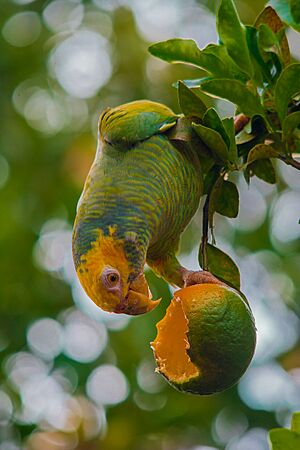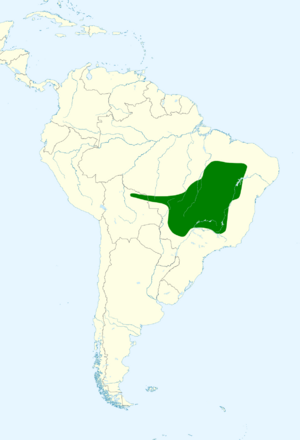Yellow-faced parrot facts for kids
The yellow-faced parrot (Alipiopsitta xanthops) is a beautiful bird with bright green and yellow feathers. It's the only type of parrot in its group, called Alipiopsitta. For a long time, people thought it belonged to the Amazona parrot family. This parrot lives in the Neotropics, which is a part of the world including Central and South America.
Quick facts for kids Yellow-faced parrot |
|
|---|---|
 |
|
| Adult | |
| Conservation status | |
| Scientific classification | |
| Genus: |
Alipiopsitta
|
| Species: |
xanthops
|
 |
|
| Synonyms | |
|
Amazona xanthops |
|
You can spot this parrot by its yellow head and mostly green body. It's a bit of a traveler, moving from place to place, especially in the cerrado region of Brazil and nearby Bolivia. Sadly, the yellow-faced parrot has lost some of its homes because of habitat destruction, which means its natural living areas are being destroyed. Because of this, it was once considered a vulnerable species. However, it can still be found in some protected areas and can even live in smaller, separated patches of its habitat. This means it's now listed as near-threatened, which is a bit better, but it still needs protection.
Contents
What is the Yellow-faced Parrot?
How Scientists Named This Parrot
A German scientist named Johann Baptist von Spix first described this parrot in 1824. He called it Psittacus xanthops. The name xanthops comes from ancient Greek words: xanthos means "yellow," and ops means "face." So, its name literally means "yellow-faced parrot"!
For many years, this parrot was grouped with the Amazona parrots. But in 1920, another scientist, Alípio de Miranda Ribeiro, thought it was different enough to have its own group, which he called Salvatoria.
Discovering Its True Family
Later, in 1995, studies looked at the parrot's genes. These studies showed that it was indeed very different from the Amazona parrots. It was actually more closely related to the short-tailed parrot and parrots in the Pionus group.
Because of this discovery, it was briefly put back into the Salvatoria group. But then, scientists found out that the name Salvatoria was already being used for a type of worm! So, the yellow-faced parrot got a brand new group name: Alipiopsitta.
What Does the Yellow-faced Parrot Look Like?
This parrot is about 27 centimeters (11 inches) long. It has a strong body and a short tail. Its feathers are mostly green and yellow. Adult parrots have a bright yellow top of the head, cheeks, and ear areas.
The rest of its head, back, and chest are green, with some yellowish-green patterns. The sides of its belly often have orange and yellow spots, and its belly can be yellow too. However, the amount of yellow on their bellies can vary a lot; some parrots have almost no yellow there.
Wings, Tail, and Other Features
Its wings are mostly green, sometimes with a few yellow spots. The edges of its main wing feathers have a blue color. The middle feathers of its short tail are green, while the side feathers are more yellow-green and have orange-red at their bases.
The parrot's beak is yellowish with a dark top part. The area above its beak (called the cere) is pinkish, and its eyes are yellow. Its legs are light grey. Male and female yellow-faced parrots look exactly the same in size and colors. Young parrots have less yellow on their heads than adults.
Where Does the Yellow-faced Parrot Live?
Its Home in Brazil and Bolivia
Most yellow-faced parrots live in central and eastern Brazil. You can find them from the states of Maranhão and Piauí all the way down to São Paulo and Mato Grosso do Sul. They prefer to live in the cerrado, which is a type of grassland and woodland on the high plains of Brazil. They also live in the drier Caatinga scrubland.
There have been a couple of sightings of these parrots in Beni, which is in northeastern Bolivia. Even though some lists say they live in Paraguay, there isn't clear proof that they are actually there.
Moving Around and Habitat Loss
Within the areas where they live, these parrots tend to be semi-nomadic. This means they move around a lot, not staying in one place for too long. Sadly, much of their natural home is being turned into farmland. This is causing the number of yellow-faced parrots to go down.
How Does the Yellow-faced Parrot Live?
What Do They Eat?
The yellow-faced parrot searches for food and eats fruits and seeds from different trees. These include trees like Anacardium species, Salacia crassifolia, and Astronium fraxinifolium. Sometimes, groups of these parrots have been seen eating crops like mangoes and unripe guavas. They also eat termites, which are a type of insect.
Reproduction and Life Cycle
Until recently, not much was known about how these parrots live. But scientists have studied them in Emas National Park in Brazil. In that area, their breeding season is from May to October.
These parrots make their nests in hollows found inside termite mounds. The eggs are kept warm for about 19 to 22 days until they hatch. After hatching, the young parrots stay in the nest for up to 45 days before they are ready to fly out on their own.
Protecting the Yellow-faced Parrot
Like most types of parrots, the yellow-faced parrot is protected by an international agreement called the Convention on International Trade in Endangered Species of Wild Fauna and Flora (CITES). It is listed on Appendix II, which means that trading these parrots across borders is controlled to make sure their populations in the wild are not harmed.
Images for kids




